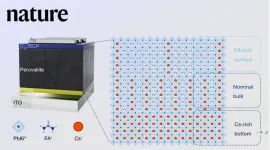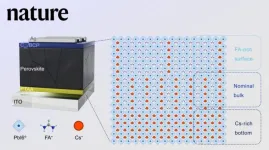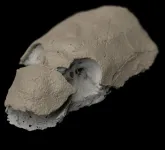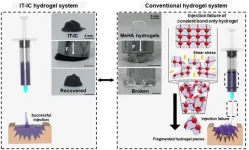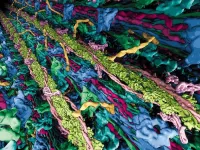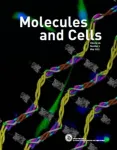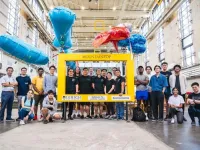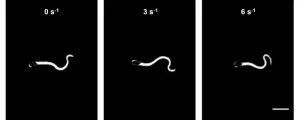(Press-News.org) If you put a hat on a starfish, where would you put it? On the center of the starfish? Or on the point of an arm and, if so, which one? The question is silly, but it gets at serious questions in the fields of zoology and developmental biology that have perplexed veteran scientists and schoolchildren in introductory biology classes alike: Where is the head on a starfish? And how does their body layout relate to ours?
Now, a new Stanford study that used genetic and molecular tools to map out the body regions of starfish – by creating a 3D atlas of their gene expression – helps answer this longstanding mystery. The “head” of a starfish, the researchers found, is not in any one place. Instead, the headlike regions are distributed with some in the center of the sea star as well as in the center of each limb of its body.
“The answer is much more complicated than we expected,” said Laurent Formery, lead author and postdoc in the labs of Christopher Lowe at the Stanford School of Humanities and Sciences and Daniel S. Rokhsar at the University of California, Berkeley. “It is just weird, and most likely the evolution of the group was even more complicated than this.”
Starfish (sea stars) belong to a group of animals called echinoderms. Echinoderms and humans are closely related, yet the life cycle and anatomy of sea stars are very different from ours.
Sea stars begin life as fertilized eggs that hatch into a free-floating larva. The larvae bob in the ocean in a plankton form for weeks to months before settling to the ocean floor to perform a magic trick of sorts – transforming from a bilateral (symmetric across the midline) body plan into an adult with a five-point star shape called a pentaradial body plan.
“This has been a zoological mystery for centuries,” said Lowe, who is also a researcher at Hopkins Marine Station and senior author of the paper that published Nov. 1 in Nature. “How can you go from a bilateral body plan to a pentaradial plan, and how can you compare any part of the starfish to our own body plan?”
Mapping stars
For puzzles such as this one, researchers often conduct comparative studies to identify similar structures in related groups of animals to glean clues about the evolutionary events that prompted the trait of interest.
“The problem with starfish is there is nothing on a starfish anatomically that you can relate to a vertebrate,” said Lowe. “There is just nothing there.”
At least, nothing on the outside of a starfish. And that is where genetic and molecular techniques come in.
During his graduate research, Formery studied early development in sea urchins – echinoderms, like sea stars, that also start their life as bilateral larvae before transforming into adults with fivefold symmetry. When Formery joined Lowe’s lab, Formery’s knowledge of echinoderm development combined with Lowe’s expertise in molecular biology techniques to help tackle the mystery of sea stars’ baffling body plan.
The team used a group of well-studied molecular markers (Hox genes are an example) that act as blueprints for an organism’s body plan by “telling” each cell which body region it belongs to.
“If you strip away the skin of an animal and look at the genes involved in defining a head from a tail, the same genes code for these body regions across all groups of animals,” said Lowe. “So we ignored the anatomy and asked: Is there a molecular axis hidden under all this weird anatomy and what is its role in a starfish forming a pentaradial body plan?”
To investigate this question, the researchers used RNA tomography, a technique that pinpoints where genes are expressed in tissue, and in situ hybridization, a technique that zeroes in on a specific RNA sequence in a cell.
“First we sectioned sea star arms into thin slices from tip to center, top to bottom, and left to right,” said Formery, noting that sea stars regenerate missing limbs. “We used RNA tomography to determine which genes were expressed in each slice and then ‘reassembled’ the slices using computer models. This gave us a 3D map of gene expression.”
“In the second method, in situ hybridization chain reaction, we stained sea star tissue and visually inspected the samples to see where a gene was expressed,” said Formery. This enabled the researchers to examine anterior-posterior (head to tail) body patterning in the outermost layer of cells called the ectoderm.
“This was made possible by the recent, big, technical improvement in in situ hybridization, known as in situ hybridization chain reaction, Formery said. “This new method provides better resolution of where the gene is expressed.”
The research revealed that sea stars have a headlike territory in the center of each “arm” and a tail-like region along the perimeter. In an unexpected twist, no part of the sea star ectoderm expresses a “trunk” genetic patterning program, suggesting that sea stars are mostly headlike.
Mining truly diverse biodiversity
Research is often centered on groups of animals that look like us, the researchers explained. But if we focus on the familiar, we are less likely to learn something new.
“There are 34 different animal phyla living on this planet and in over roughly 600 million years they have all come up with different solutions to the same fundamental biological problems,” Lowe said. “Most animals don’t have spectacular nervous systems and are out chasing prey – they are modest animals that live in burrows in the ocean. People are generally not drawn to these animals, and yet they probably represent how much of life got started.”
This study demonstrates how a comparative approach that uses genetic and molecular techniques can be used to mine biodiversity for insights into why different animals look the way they do and how their body plans evolved.
“Even in recent molecular papers there’s a question mark near echinoderms on the evolutionary tree because we don’t know much about them,” Formery said. “It was nice to show that – at least at the molecular level – we have a new piece of the puzzle that can now be put on the tree.”
Formery, Lowe, and Rokhsar are also researchers at the Chan Zuckerberg BioHub. Rokhsar is also a researcher at the Okinawa Institute of Science and Technology. Additional Stanford co-authors are Ian Kohnle, Judith Malnick, and Kevin Uhlinger of Hopkins Marine Station. Additional authors are from Pacific Biosciences in Menlo Park, California, and Columbia Equine Hospital in Gresham, Oregon.
This research was funded by NASA, the National Science Foundation, and the Chan Zuckerberg BioHub.
END
Study reveals location of starfish’s head
2023-11-01
ELSE PRESS RELEASES FROM THIS DATE:
Scientists propose perovskite films homogenizing strategy to increase conversion efficiency
2023-11-01
In a study published in Nature, researchers from the Hefei Institutes of Physical Science (HFIPS) of the Chinese Academy of Sciences have proposed a new and promising method of fabricating homogenized perovskite films for solar cells. The process involves inhibiting phase segregation caused by internal cation inhomogeneity to increase conversion efficiency to 26.1%, thus tying the existing record.
Their work was also featured as a Nature Editor’s Pick.
For solar cells, an important alternative energy ...
Scientists propose perovskite film homogenizing strategy to increase conversion efficiency
2023-11-01
In a study published in Nature, researchers from the Hefei Institutes of Physical Science (HFIPS) of the Chinese Academy of Sciences have proposed a new and promising method of fabricating homogenized perovskite films for solar cells. The process involves inhibiting phase segregation caused by internal cation inhomogeneity to increase conversion efficiency to 26.1%, thus tying the existing record.
Their work was also featured as a Nature Editor's Pick.
For solar cells, an important alternative energy source, the pursuit of higher conversion efficiency and the attempt to keep the cells table as long as possible are core issues that scientists and engineers all over the world are ...
How the fish got its shoulder
2023-11-01
A new analysis of the bones and muscles in ancient fish gives new clues about how the shoulder evolved in animals – including us.
The shoulder girdle – the configuration of bones and muscles that in humans support the movement of the arms – is a classic example of an evolutionary ‘novelty’. This is where a new anatomical feature appears without any obvious precursors; where there is no smoking gun of which feature clearly led to another.
The new research, which draws together a range of evolutionary investigation techniques including fossils, ...
New “injectable tissue prosthesis coupled with closed-loop bioelectronic system” to aid in damaged muscle/nerve regeneration and robot-assisted rehabilitation
2023-11-01
In a recent publication in the journal Nature, researchers from the Institute of Basic Science (IBS) in South Korea have made significant strides in biomaterial technology and rehabilitation medicine. They've developed a novel approach to healing muscle injury by employing “injectable tissue prosthesis” in the form of conductive hydrogels and combining it with a robot-assisted rehabilitation system.
Let’s imagine you are swimming in the ocean. A giant shark approaches and bites a huge ...
Breakthrough discovery sheds light on heart and muscle health
2023-11-01
Atrial fibrillation, heart failure and stroke – hypertrophic cardiomyopathy can lead to many serious health conditions and is a major cause of sudden cardiac death in people younger than 35. „The heart muscle is a central engine of the human body. Of course, it is easier to fix a broken engine, if you know how it is built and how it functions”, says Stefan Raunser. “At the beginning of our muscle research we have successfully visualized the structure of the essential muscle building blocks and how they interact using electron cryo-microscopy. However, these were static images of proteins taken out of the living cell. They only tell us little ...
Chemical process makes peptide acquire structure similar to amyloid plaques found in neurodegenerative diseases
2023-11-01
Peptides are biomolecules formed when two or more amino acids that perform key functions in the human organism, such as hormones, neurotransmitters, painkillers and antibiotics, bind together. For this reason, they are much studied and used by the pharmaceutical industry, for example.
A study conducted by scientists in the Department of Biophysics at the Federal University of São Paulo's Medical School (EPM-UNIFESP) in Brazil identified significant changes in the physicochemical properties of peptides during a spontaneous process of chemical change called pyroglutamination.
Pyroglutamination is a modification resulting from spontaneous conversion ...
Elsevier partners with the Korean Society for Molecular and Cellular Biology to publish Molecules and Cells
2023-11-01
Amsterdam, November 1, 2023 – The Korean Society for Molecular and Cellular Biology (KSMCB), one of the largest and most prominent academic societies in the field of life sciences in Korea, and Elsevier, a leader in information and analytics for customers across the global research and health ecosystems, are pleased to announce a new partnership to publish Molecules and Cells, the flagship journal of KSMCB. This English-language publication will be hosted on Elsevier’s industry-leading online platform of peer-reviewed literature, ScienceDirect, beginning January 1, 2024. Continuing ...
Do physical connections improve the control and performance of robot swarms?
2023-11-01
In nature, swarms can accomplish amazing things. Schools of fish can more efficiently find food and migrate. Flocks of birds can confuse predators. Bees, ants, and termites can work together to feed, defend and build their colonies.
Robotics researchers have long been trying to harness this ability to explore environments, capture objects and build structures using robot swarms.
“But the problem of how do we efficiently control all those robots is still unsolved,” says David Saldaña, an assistant professor ...
Dr. Jennifer Lotz appointed Space Telescope Science Institute Director
2023-11-01
The Association of Universities for Research in Astronomy (AURA) is pleased to announce the appointment of Dr. Jennifer Lotz as the Director of the Space Telescope Science Institute (STScI). Dr. Lotz will begin her five-year appointment as STScI Director starting February 12, 2024. Previously, Dr. Lotz was the Director of the International Gemini Observatory which is operated by NSF’s NOIRLab, and managed by AURA.
“Dr. Lotz is a science driven, accomplished leader,” said Dr. Matt Mountain, President of AURA, which manages STScI on behalf of NASA. “Jen’s passion for the Institute’s mission, to enable the ...
Sperm adjust their swimming style to adapt to fluctuating fluid conditions
2023-11-01
Sperm can modulate their energetics by regulating their flagellar waveform—how the sperm oscillate their tails—in order to adapt to varying fluid environments, potentially optimizing their motility and navigation within the reproductive tract. This research is reported in a study publishing November 1 in the journal Cell Reports Physical Science.
“Our approach allowed us to investigate how variations in viscosity and shear rates affect sperm behavior at the single-cell level, which was not possible using traditional methods,” says senior study author Reza Nosrati of Monash University.
Biochemical and biophysical cues within the reproductive ...
